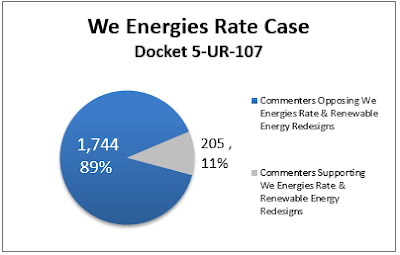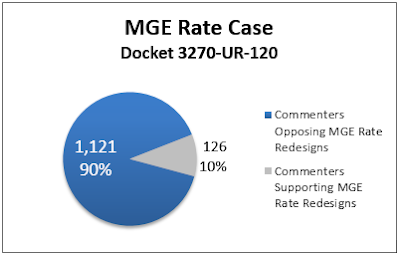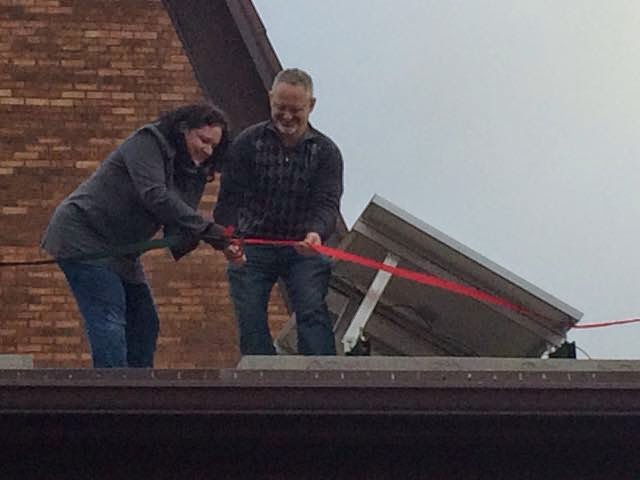
by jboullion | Dec 19, 2014 | Uncategorized
Two Madison Churches Tap into a Higher, Cleaner Power
by Michael Vickerman
December 18, 2014
The sun is shining a little brighter this December on two church congregations in the Schenk-Atwood neighborhood. Zion Lutheran and Trinity Lutheran churches are commissioning rooftop solar photovoltaic arrays that, once energized, will help power good works in and around Madison’s East Side.
Trinity Lutheran Church, 1904 Winnebago Street, will host a post-Sunday service ceremony on the winter solstice, December 21st, starting at approximately 10:30am. Pastor Susan Schneider will deliver a blessing upon the 19.9 kW solar project, followed by a ribbon-cutting ceremony featuring local solar developer Kurt Reinhold and RENEW Wisconsin’s Michael Vickerman. For more information, contact Michael at mvickerman@renewwisconsin.org or call (608) 255.4044×2.
 |
| Photo Cred: Sustainable Atwood |
Zion Lutheran Church, 2165 Linden Avenue, near Atwood Avenue, held its ribbon-cutting ceremony on December 17th. Intern pastor Stacy Gahlman-Schroeder led the dedication ceremony, followed by Pastor Jeff Wild from Advent Lutheran, which donated the panels to Zion.
Both Zion and Trinity’s installations should be fully energized before the weekend. Both churches are combining solar with efficiency improvements to maximize the value of the energy they use while at the same time improving public health, reducing environmental pollution, and cutting operational costs.
Background. Sustainable Atwood’s Solar Program helped bring the parties together for each of these two churches as part of its mission to move the neighborhood in the direction of a cleaner and more sustainable energy future. Zion Lutheran now hosts the offices of Sustainable Atwood’s community operations, and became the spark for this joint venture. Until recently, the solar panels now on Zion’s parish roof graced a Madison west side church—Advent Lutheran, off Old Sauk Road. When it commissioned its 2.8 kW PV system in late 2002, Advent Lutheran became the first solar-powered church in Wisconsin. These panels were taken down in 2013 when Advent’s roof was replaced. Instead of putting its 12-year-old photovoltaic system back on its roof, Advent’s congregation decided to acquire a much larger array, which was installed and commissioned in July 2014. Instead of selling their 18 panels, which even after 12 years will operate at 94% of their original productivity, Advent donated them to Sustainable Atwood.
Burke and Mark O’Neal, the brothers who own the solar contracting company Full Spectrum Solar on East Washington Avenue, are sponsors of Trinity Lutheran Church’s solar project, which consists of 78 panels atop the south-facing roof along First Street. Members of the congregation and community residents can support this project through Sustainable Atwood’s Switch-to-Solar program. For more information on this and other community solar projects, please contact Solarconnections@gmail.com.
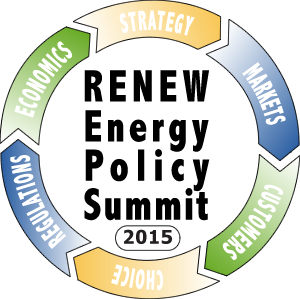
by jboullion | Dec 16, 2014 | Uncategorized
Immediate release
December 17, 2014
More information
Tyler
Huebner, Executive Director
608.255.4044
x 1
Keynotes and Agenda Set for January Renewable Energy Policy Summit
Event Aims to Unlock the
Clean Energy Transition
 RENEW Wisconsin will host
RENEW Wisconsin will host
its fourth annual Renewable Energy Policy Summit on Friday, January 9th, 2015
at UW-Madison’s Union South. The theme of the event, “Unlocking the Clean
Energy Transition,” will highlight the importance of renewable energy to
Wisconsin’s economy. The early-bird registration deadline is Saturday, December
20th.
The event will feature two
keynote speakers. They are:
- Brad Klein, Senior Attorney at the Environmental Law &
Policy Center, will kick off this year’s program. Brad will cover the recently
concluded utility rate cases, and the Iowa Supreme Court ruling in 2014 which
allowed third-party financing of solar.
- Jigar Shah, President of Generate Capital and founder of
SunEdison, will deliver the afternoon address. Widely known as a clean energy visionary, Jigar
will offer his perspective on the emerging opportunities for powering the
economy of the future with clean energy’s impact on the economy.
Between the opening and
closing keynotes, panelists and presenters will emphasize the economic and
business opportunities for renewable energy, highlighting new planning initiatives,
projects and anticipated regulatory changes. These include:
-
A morning panel of state and local policymakers will discuss
targeted efforts to advance renewable energy options as state energy policy
evolves. The panel will feature Representative Chris Taylor (D-78 Madison) and Matt
Howard, Sustainability Director for the City of Milwaukee. Additional legislators and local officials
have been invited.
- A lunchtime presentation on Vernon Electric
Cooperative’s trail-blazing community solar installation, located alongside its
headquarters in Westby.
- Four afternoon presentations examining scenarios for
expanding renewable energy market share:
—What’s Next for Solar (Matt Neumann, owner, Pewaukee-based
SunVest Solar)
— Bioenergy and Energy Independence (Jeff Rich, director
of the Envision energy initiative for La Crosse-based Gundersen Health System)
— Big Vision for Wisconsin’s Renewable Energy (Jane
Elder, executive director of Wisconsin Academy of Science, Arts, and Letters)
–Renewable Energy for the Clean Power Plan (Gary
Radloff, Director, Midwest Energy Power Analysis, UW Energy Institute)
Following the afternoon
keynote, an awards ceremony will recognize the most noteworthy installations
energized in 2014 and honor Wisconsin leaders in renewable energy.
RENEW Wisconsin’s
Executive Director Tyler Huebner says, “We chose this year’s theme to highlight
the tremendous economic development potential for Wisconsin from harvesting
more of its own home-grown energy sources, and contrast it to the current
uphill battle many renewable energy businesses currently face in this
state.”
The early-bird deadline
for registration is Saturday, December 20th. Early-bird rates are $85 for
Members of RENEW Wisconsin and $110 for non-members, and rates will go to $95
and $125 respectively after the deadline. The rate for government employees is
$85 and for students is $35; these two rates won’t change with the deadline.
Membership with RENEW starts at $35 for individuals and $200 for businesses and
organizations.
-END-
RENEW
Wisconsin leads and accelerates the transformation to Wisconsin’s renewable
energy future through advocacy, education, and collaboration. More information on RENEW’s Web site
at www.renewwisconsin.org.
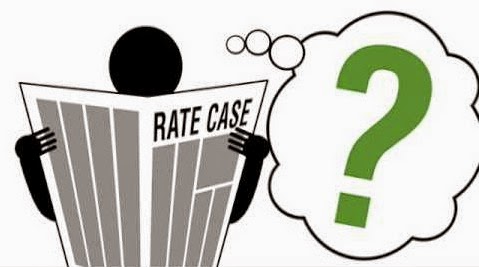
by jboullion | Dec 1, 2014 | Uncategorized
In a 2-1 decision on Wednesday, November 26,
2014, the Public Service Commission approved Madison Gas & Electric’s
request to increase monthly fees for all customers starting in 2015.
For residential customers, electricity service
will cost $19 each month before using any energy, and natural gas service will
cost $21.87 each month before using any gas.
For a residential customer with both electricity and gas, monthly fees
will go from $22.61 up to over $40.
Commissioners Phil Montgomery and Ellen Nowak,
as they have for Wisconsin Public Service and We Energies in recent cases, supported these
changes, while Commissioner Eric Callisto disagreed and would have limited
these increases while opening a broader discussion on the topics.
A number of decisions were reached on these
issues, which are outlined below:
· Overall residential customers for electricity will see on average an increase of about
3.5%. Small commercial customers will have an increase of about 1%, while
larger business and industry customers will see a higher increase of around 4%.
· Fixed monthly charges for residential electricity service will be $19
· Fixed monthly charges for residential natural gas service will be $21.87
· Customers with existing solar and small wind systems will be
“grandfathered” under the current rates for 12 years
· Customers who subscribe to “Green Power Tomorrow,” the voluntary
program where customers pay extra to participate in renewable energy projects,
will pay less for that service. The
premium price will be reduced from 4 cents per kilowatt-hour down to 2.44 cents
per kilowatt-hour.
· Chairperson Montgomery offered some advice to MG&E on the
collaborative process they intend to have with customers and communities they
serve.
o MG&E should look at instituting extra fees on customers with solar
and other forms of “distributed generation” and reducing the payback, as We
Energies proposed (and was approved)
o MG&E should institute monthly “netting” of distributed generation
o Approaches such as the “value of solar” are not needed because the
current wholesale market sets the price.
o Any extra electricity created, but not used, by those distributed
generation systems should be paid at the wholesale market price, which is in
the range of four cents per kilowatt-hour, instead of being credited at retail
rates which are closer to 13-14 cents.
The Commission voted not to approve a separate
arrangement that would shield low-income customers from these fixed rate hikes. Therefore, all customers will be exposed to
the fixed rate increases in 2015.
by jboullion | Nov 14, 2014 | Uncategorized
RELEASED FRIDAY, NOVEMBER 14, 2014
MADISON, WI – With a 2-1 vote voiced at an open meeting Friday afternoon, the Wisconsin Public Service Commission approved a 75% increase in monthly fixed charges and sweeping changes that will pile additional charges on customers who choose to install solar energy panels starting in 2015. The vote was split down partisan lines with Gov. Scott Walker appointees Chairperson Phil Montgomery and Commissioner Ellen Nowak supporting the changes; and Commissioner Eric Callisto, an appointee of Gov. Jim Doyle, opposed.
“Under this decision, customers who use more will see lower bills and customers who use less will see higher bills. It sends the wrong price signals on energy efficiency because it makes it harder for customers to control their monthly bills,” said Robert Kelter, senior attorney with the Environmental Law & Policy Center.
“The Public Service Commission has effectively approved a new tax to be collected from residential and small business customers that would like to create some of their own energy, such as with solar panels,” said Tyler Huebner, executive director of RENEW Wisconsin. “This decision is bad for job creation, bad for energy independence, bad for the environment, and bad for customers. Today our Republican-appointed Commissioners approved a new tax, killed jobs, and restricted energy choice in Wisconsin.”
“The commission has ignored the facts in this case and decided whether you embrace energy efficiency, or want to generate some of your own electricity with solar panels, you should pay more,” Kelter said.
“It also ignored a record level of over 1,900 public comments, 89% of which were opposed to these changes,” Huebner added.
The Public Service Commission decision will:
- Increase monthly fixed fees from $9.13 to $16.00
- Impose a $3.79 monthly tax on every kilowatt of a solar installation (a 4 kilowatt system would pay $181.97 a year)
- Transfer about 40% of the value of solar installation from the homeowner to We Energies through changes in payments and charge
- Pay just 4.2 cents for every kilowatt-hour of energy generated by customer renewable energy systems
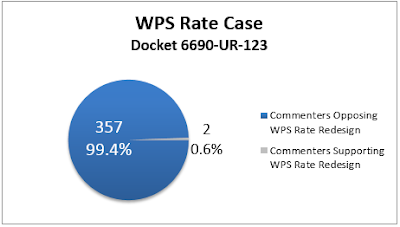
by jboullion | Nov 12, 2014 | Uncategorized
A new analysis conducted by RENEW Wisconsin of the public comments filed in three controversial utility rate cases shows that over 90% of the more than 3,500 public comments offered are opposed to the rate hikes and changes to how customers with renewable energy systems will be treated. Read the full report, “Wisconsin Utility Rate Redesigns Overwhelmingly Unpopular“.
In addition to the analysis, the report includes several quotes from the large variety of stakeholders who made their voices heard in this public process, and a listing of businesses and organizations that made time to participate. From seniors to social workers, businesses to students, shareholders to household Wisconsin brands like Organic Valley, people and organizations made public comments in record numbers.
The three utilities that have proposed these changes include Wisconsin Public Service (WPS) out of Green Bay, We Energies based in Milwaukee, and Madison Gas & Electric (MGE). A typical rate case receives comments numbered in the dozens at most. WPS’ case received nearly 360 comments, with only 2 individuals supportive of the change. That means over 99% of commenters in the WPS case were in opposition to the fixed rate hike.
In addition to those comments, over 7,500 individuals signed onto petitions opposing the rate change for WPS, and those petitions were also entered into the record.
Comments for We Energies and MGE were due a month later, in early October, and the volume of comments hit an even higher order of magnitude. Approximately 1,950 comments were offered in the We Energies case and 1,250 in MGE’s, with 89% and 90% opposed in those respective proceedings.
“The public showed tremendous concern for the bill increases, reduced incentive to conserve energy, and reduced customer control over their energy bill that these proposals will bring about. With so many comments filed, we wanted to make sure that the volume and tremendous content from the public was summarized and presented for the world to see,” said RENEW Wisconsin’s Executive Director, Tyler Huebner.
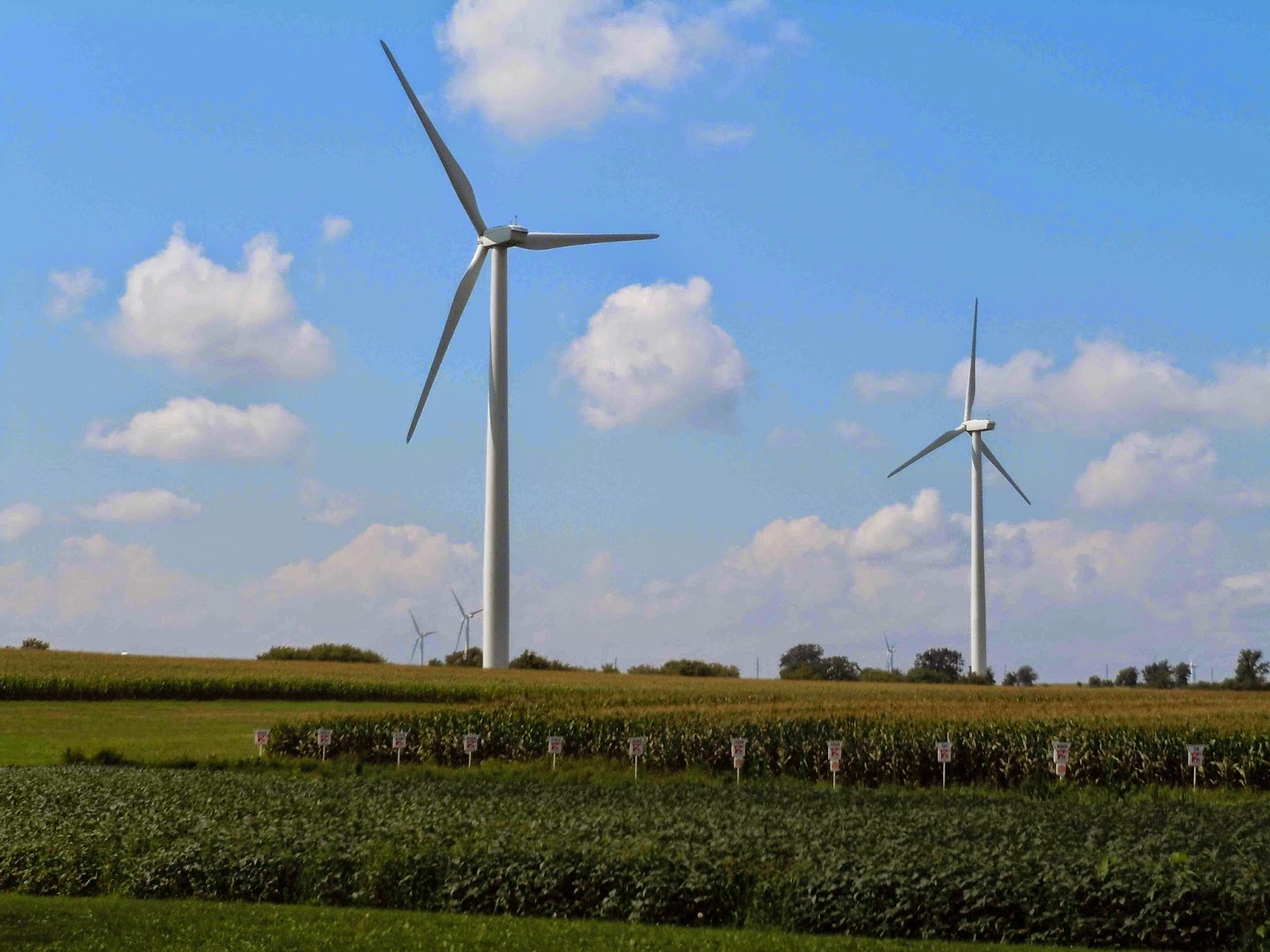
by jboullion | Nov 10, 2014 | Uncategorized
 |
| Photo of Forward Wind Project, in Fond du Lac and Dodge Counties |
Five years after the adoption of Wisconsin’s wind siting law (2009 Act 40), Wisconsin’s Wind Siting Council, a 15-member stakeholder body created by that law, prepared and issued a report reviewing pertinent peer-reviewed literature on the effects of wind generators on human health. The report also includes a study of state and national regulatory developments regarding wind siting, and discusses current policy trends regarding the siting and permitting of wind energy systems. Both the Public Service Commission (PSC) and the Legislature received copies of this report. The report is accessible on the PSC’s website here.
In the years following the development of Wisconsin’s wind siting rule (PSC 128) in 2010, council members collected literature addressing health effects of wind energy systems. The Council restricted its review to literature that specifically focused on human health. Pertinent literature included empirical research, reviews and opinion articles appearing in peer-reviewed scientific journals and reports from government entities, an example being the January 2012 report issued by the Massachusetts Department of Environmental Protection and Public Health.
In addition to the primary report, which was supported by a majority of council members, there are two minority perspectives contained in the report’s appendices. The conclusions and recommendations supported by the Council majority are summarized below:
Key Findings from Wind-Health Literature (pages 2-3)
- Nine publications based on cross-sectional surveys of individuals living in the proximity of utility-scale wind energy systems have been conducted or analyzed since the Council’s 2010 recommendations.
- Some individuals living in the proximity of wind systems may experience annoyance and a small faction report sleep disturbance due to wind turbine operation.
- Stress and sleep disturbance may be related to chronic health conditions.
- There are substantial differences in how people report their perception of wind energy systems and a negative perception affects whether an individual reports adverse health effects that they attribute to wind energy systems.
- The majority of individuals living near utility-scale wind systems do not report stress, sleep deprivation, or chronic health effects attributed to wind turbines.
Conclusion – Health Impacts (page 16)
“Although there are several publications arguing that noise from wind turbines directly causes adverse health effects in humans, based on the peer-reviewed literature, it appears at this time that there is insufficient data to validate this scientific conclusion. It will be a priority of the Council to continue surveying the peer-reviewed literature to determine if this consensus changes, if a viable mechanism of “infrasound and low-frequency noise”-caused adverse health effects is shown, and if the medical community identifies a disease associated with wind-turbine noise exposure. Although important and indeed ground-breaking research is clearly being conducted in the field of wind-health interactions, the Council is unable, at this time, to conclude that wind turbines have a direct and negative effect on human health.
As it stands, the literature available to the Council lacked strength and, in some instances, was biased. Many of the authors of the material cited herein point this out and call for more detailed, randomized, long-term studies in the future. The Council is aware of at least one study [Government of Canada, Health Canada and Statistics Canada] being conducted by a government panel that is designed to do just that and at least one additional governmental review of the literature. These may shed light on new health issues associated with wind turbines or confirm the Council’s finding that there is no direct link between wind turbines and human health. At the very least, ongoing research should clarify the sometimes muddy waters of the wind-health debate.”
Conclusion – Policy Developments (page 22)
“Wisconsin’s siting regulations for wind energy systems are evidently consistent with other and national policy regulatory developments. It is clear that in future projects, Wisconsin should continue to provide a transparent regulatory and approval process for wind developers, as well as keep in mind that best practices should be determined by the best available information about the relationship between wind energy systems and siting and zoning.”
No Recommendations for Legislation (page 4)
“Wisconsin’s wind siting rule, Wis. Admin. Code ch. PSC 128, is the product of an extensive and transparent review process and has been in effect since March 16, 2012. Absent any specific information arising from a wind project reviewed and approved under PSC 128, and based on the survey of peer-reviewed scientific research regarding the health impacts of wind energy systems, and the study of state and national regulatory developments regarding the siting of wind energy systems, the Council majority finds no reason at this point to recommend legislation regarding the siting of wind energy systems.”
Postscript:
One week following the issuance of the Wisconsin Wind Siting Council’s report, the Canadian government released its Wind Turbine Noise and Health Study. In that study, researchers from Health Canada and Statistics Canada conducted a door-to-door survey involving more than 1,200 households in Ontario and Prince Edward Island. The study found no cause-and-effect relationship between wind turbine noise and any negative health indicators identified through the testing.
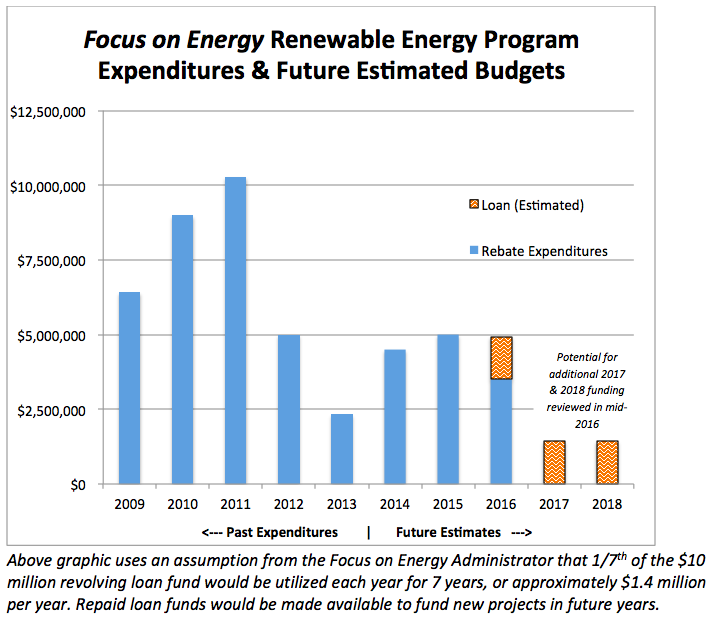
by jboullion | Nov 7, 2014 | Uncategorized
November 7, 2014
For Immediate Release
MADISON — In a 2-1 decision made Thursday, November 6, the Public Service Commission approved a four-year redesign of Focus on Energy’s renewable energy program that will offer $5 million in cash-back incentives for qualifying projects in 2015 and $3.5 million in 2016. The statewide renewables program will also establish a new $10 million revolving loan fund which would start taking applications in 2015 for projects in 2016 through 2018.
The approved plan does not commit incentive dollars to renewable energy projects in 2017 and 2018. Instead the Commission requested a report in mid-2016 to review funding options for those two years.
Yesterday’s decisions came after Commission deliberations in July which resulted in a preliminary decision to end the cash-back rebates entirely and replace them with a loan program. After discussions with RENEW and other energy stakeholders, the Commission asked for funding options that included a continuation of direct incentives, resulting in yesterday’s vote on the redesigned program.
The renewable energy plan, which was approved by Chairman Phil Montgomery and Commissioner Ellen Nowak, sets a total of $5 million in cash-back rebates for 2015 and $3.5 million in 2016. In his dissenting vote, Commissioner Eric Callisto signaled his support for more incentives: $6.67 million in incentives for each year of 2015 to 2018, with a smaller loan program.
Undercutting the impact of the 2015 allocation is the fact that $4.2 million of the $5 million total has already been allocated to projects, leaving only $800,000 in new funding for next year. Approximately $450,000 will be available for solar and geothermal for residential and small businesses in each of the next two years, with the remaining funding towards larger projects for businesses, farms, and nonprofits.
“The renewable energy cash-back rewards have been instrumental in building a market for customers to take advantage of the benefits of solar, small wind, geothermal, and bioenergy projects in Wisconsin for many years,” said Tyler Huebner, RENEW Wisconsin’s Executive Director. “It has helped build a marketplace for these technologies and a robust network of small businesses helping customers in this state. Over the past four months, RENEW Wisconsin worked with members of the renewable energy business community, the administrator of the Focus on Energy program, and staff at the Public Service Commission to ensure some level of rebates would continue, and we achieved a small victory but not as much funding or the four years of certainty for which we were hoping.”
“It appears only $800,000 in rebates will be available for newly identified projects in 2015, and that is a big concern for our industry,” said Huebner, “because this program has already been hard hit by on-again off-again funding interruptions over the past few years.”
The loan program would be based largely on a successful program in Iowa called the Alternative Energy Revolving Loan Program. Funds would be lent out from Wisconsin’s Focus on Energy program for very low interest rates for up to 50% of a project’s cost, and matched with a loan from a financial institution at market interest rates for the remainder of the project. CB&I, the Focus on Energy program administrator, has estimated that 1/7th of the $10 million would be spent each year for 7 years, enabling the payback of the loans to fund additional loans in future years.
The Commission also decided to eliminate the defined split between certain types of technologies. Over the past four years, biogas and biomass projects received more funding than wind and solar. “Going forward, that defined technology split will be removed as far as RENEW Wisconsin understands, and that is a welcome change,” said Huebner.
Back in July, the Commission also approved a $6 million program aimed at anaerobic digesters for dairy farms. That program would explore ways to utilize the biogas digester technology on smaller dairy farms. “Continued investment into biogas is needed so we can identify more opportunities to recover energy and valuable by-products from cow manure, and reduce concerns about runoff and water quality issues,” said Huebner.
Renewable energy is a growing field nationally, with over 143,000 jobs in solar energy alone, according to the Solar Foundation’s National Solar Jobs Census in 2013. That’s more than the U.S. auto industry and almost 50,000 more than the U.S. coal mining industry.
“We need to continue our focus in Wisconsin on job creation, and the clean energy sector is a job-creating sector. All we have to do is look to our neighboring states of Iowa, Minnesota, and Michigan to look at the robust job markets in renewable energy. For example, Michigan was just named the sixth best state nationally for clean energy jobs growth,” concluded Huebner.

by jboullion | Sep 30, 2014 | Uncategorized
Michael Vickerman
RENEW Wisconsin
September 30, 2014
Craig Tarr of Energy Concepts at the Dane County Airport solar array
One of
Wisconsin’s largest solar electric systems is now supplying clean renewable
energy to the Dane County Regional Airport.
Online since late August, the 100 kilowatt array sits on the roof of the
airfield’s new maintenance building, and will generate 50% of the electricity
consumed at this two-story, 58,000-square-foot facility. The maintenance
building is located on the southwest corner of the airfield.

Dane County Executive Joe Parisi (center) at the dedication ceremony on Thursday, September 25th.
Not only is
Dane County’s solar project the largest owned by a Wisconsin local government,
it is the largest serving an airfield in the Badger State. The system’s 376
panels are expected to generate 135,000 kilowatt-hours per year, the annual
equivalent to the usage of 22 residences in Madison Gas & Electric
territory.
Hudson,
Wisconsin-based Energy Concepts designed and installed the $300,000 solar
electric system. Suniva, a Georgia
company, manufactured the 65” x 39” panels. Each panel weighs 40 pounds.
In its first
30 days of operation, Dane County’s solar electric system produced 13,270
kilowatt-hours, about 24% higher than engineering estimates, according to
Energy Concept’s Craig Tarr, who designed the array and oversaw its
installation.
The Federal
Agency Administration provided 80% of the funding for the entire facility,
including the solar electric array. Dane
County officials said the total installed cost of the airport was approximately
$300,000, or $3.00 per watt.
Dane County’s solar array marks the eighth PV
array installed in Wisconsin this year with a rated capacity of 100 kW or greater
(see table below). With the exception of
Dairyland Power’s solar array were driven, all the projects listed below are
either owned by a utility customer or are financially supported by
self-selecting customers. As of this
moment, solar generating capacity in Wisconsin totals 18 megawatts, which is
comparable to Minnesota’s solar presence.
Customer-Supported Solar Generation in Wisconsin
Top 2014 installations
|
Installation
Owner or Host
|
County
|
KW
|
Installer
|
|
Dairyland Power Cooperative
|
Vernon
|
517
|
Clean Energy Collective/VEC
|
|
Vernon Electric Cooperative
(VEC)1
|
Vernon
|
305
|
Clean Energy Collective/VEC
|
|
Holy Wisdom Monastery
|
Dane
|
1262
|
H&H Solar
|
|
AMI
|
Brown
|
113
|
Eland Electric
|
|
Griffin Industries
|
Brown
|
113
|
Eland Electric
|
|
Sisters of St. Francis
|
Brown
|
112
|
Eland Electric
|
|
St. Croix Electric
Cooperative3
|
St. Croix
|
103
|
Unknown
|
|
Dane County Regional Airport
|
Dane
|
100
|
Energy Concepts/ Steiner
Electric
|
|
Barron Electric Cooperative4
|
Barron
|
80
|
Carr Creek Electric
|
|
AMI
|
Brown
|
53
|
Eland Electric
|
|
Bellin Health
|
Brown
|
49
|
Eland Electric
|
1 Community solar garden supported by Vernon
Electric Cooperative owner-members
2 The 126 kW added this year raises the
overall capacity there to 146 kW
3 Community solar garden supported by St.
Croix Electric Cooperative owner-members
4 Community solar garden supported by Barron
Electric Cooperative owner-members
Links:
Photos of Dane County Airport’s PV array and the
September 26, 2014, press conference.
Images of Dane County Regional Airport’s new maintenance
facility.
https://www.flickr.com/photos/msnairport/sets/72157646736371339/
Wisconsin State Journal article (09-27-2014)
by jboullion | Aug 28, 2014 | Uncategorized
Experts find no evidence to support proposal
Press Release from RENEW Wisconsin and Environmental Law & Policy Center
August 28, 2014
MADISON, WI – Expert witnesses criticized We Energies’ proposals to raise “fixed” charges for everyone and add fees and restrictions to customers that wish to generate clean, renewable energy on their own property, in testimony filed Thursday with the Public Service Commission of Wisconsin.
Experts for RENEW Wisconsin and the Environmental Law & Policy Center determined that We Energies’ proposed billing changes are unjustified, would reduce all customers’ ability to control their electricity bills, and would stifle the growth of energy efficiency and renewable energy.
Karl Rábago of Rábago Energy, LLC called the proposal “an astounding failure of basic ratemaking” and determined that the Company provided “no reasonable justification” for imposing charges on their customers.
Michael Vickerman of RENEW Wisconsin concluded the proposal would cripple the solar industry in Wisconsin, and would reduce a customer’s return from a new solar system by more than one-third (35%) and slash savings from an existing system by nearly one-half (47%).
Brad Klein, senior attorney at the Environmental Law & Policy Center, called the proposal a dangerous precedent. “We Energies is attempting to exert its monopoly power to restrict customer choice and take money out of the pockets of customers who use less energy.”
Tyler Huebner, executive director of RENEW Wisconsin said, “We Energies’ proposals, if approved, would punish customers who have done the right thing by going solar, and take away jobs for the small businesses that make a living in this industry which has grown nationally to over 140,000 employees through 2013.”
The new charges and service restrictions contemplated by We Energies include:
§ Increasing monthly fixed charges by more than 75%, which would disproportionately affect customers that use less energy (see “Robin Hood in Reverse” release)
§ Adding a new “capacity demand” charge that alone will offset nearly 30% of a customer’s savings from solar
§ Paying solar generators just 4.2 cents for each extra kilowatt-hour of electricity they create, while re-selling that electricity to other customers at up to 28 cents during peak daytime summer hours
§ Restricting solar energy financing options that help low-income customers, municipalities, churches and non-profits more affordably go solar
The expert witnesses’ main recommendations were to reject the utility’s proposals. “A broader discussion is needed to enable us to ‘look before we leap’ – to carefully examine both the benefits and costs of customers producing their own clean power before simply accepting this utility’s view,” said Huebner.
More information:
· RENEW Wisconsin’s testimony in this We Energies case can be found at the Public Service Commission’s website, http://psc.wi.gov/apps35/ERF_search/default.aspx, by searching for Docket 5-UR-107.
· Testimony in this case comes on the heels of testimony filed two weeks ago in the Wisconsin Public Service rate case, Docket 6690-UR-123, which RENEW Wisconsin characterized as “Robin Hood in Reverse.”
· RENEW also recently discussed We Energies’ proposed changes which would affect future biogas projects. See press release.
RENEW Wisconsin is an independent, nonprofit 501(c)(3) organization that leads and accelerates the transformation to Wisconsin’s renewable energy future through advocacy, education, and collaboration.
ELPC is the Midwest’s leading public interest environmental legal advocacy and eco-business innovation organization. We develop and lead successful strategic advocacy campaigns to improve environmental quality and protect our natural resources.
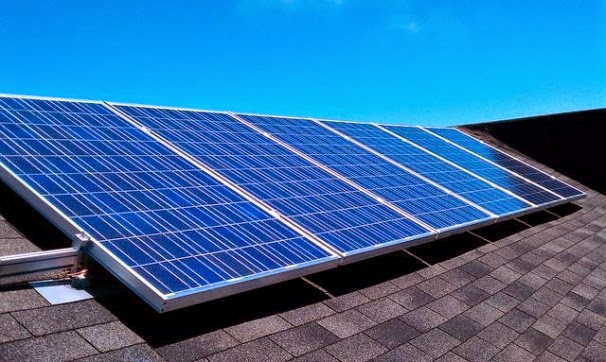
by jboullion | Aug 28, 2014 | Uncategorized
RENEW’s Michael Vickerman is featured extensively in this article.
‘Unprecedented’ attempt to destroy solar industry and penalize clean energy users in Wisconsin
By Lisa Kaiser
August 27, 2014
 At the very moment solar energy is becoming an affordable, realistic option for homeowners and businesses, the state’s largest utility, We Energies, is attempting to strike a fatal blow to this emerging industry.
At the very moment solar energy is becoming an affordable, realistic option for homeowners and businesses, the state’s largest utility, We Energies, is attempting to strike a fatal blow to this emerging industry.
In its latest rate request in front of the state Public Service Commission (PSC), We Energies is seeking to charge its customers more and also add new penalties to those who use renewable energy, making solar panels and other green systems less affordable for the average property owner.
Renewable systems owners represent just a fraction of 1% of We Energies’ 2.2 million customers in eastern Wisconsin and Upper Michigan.
But, plagued by flat sales in a weak economy and bogged down by the high debt service costs for the expenditures We Energies made in its fossil fuel-based fleet and transmission lines, We Energies is turning to its most energy-efficient and independent customers for new sources of revenue.
Essentially, We Energies is asking its customers, who have tried to be more energy efficient, to pay higher fees to cover the costs for the backward-looking decisions We Energies made when it invested billions of dollars in what many people viewed as “dinosaur technology” 10 years ago. The We Energies executives got nice bonuses and we, the ratepayers, got stuck paying for these bonuses.
Instead of promoting clean energy and energy efficiency or competing on a fair playing field, We Energies wants to punish it.
In effect, if you use little energy—whether you’ve got solar panels on your house or not—you’re going to pay more for your electricity in January 2015 if We Energies gets its way.
“They don’t like customers using less of their energy, it’s as simple as that,” said Michael Vickerman, RENEW Wisconsin’s program and policy director. “They want customers to be completely dependent on utility-supplied energy.”
The Request
We Energies’ proposed rate change is focused on its fixed charges—the ones covering We Energies’ investment in the grid, what’s called a “facilities charge” on your bill—and the more variable energy rate. We Energies seeks to increase that base facilities charge from $9 month to $16 a month for an average homeowner. Customers with renewable energy systems would see additional charges.
If granted, residential customers would see a 5% increase in their electricity rates next year, the Journal Sentinel reported.
We Energies spokesman Brian Manthey said the strategy aims to be transparent by showing customers how their payments are being used.
The monopoly is trying to sell its changes by insisting they’re “fair” by requiring all customers to pay into the grid, even those who only use it sporadically, such as solar owners.
“The cost should not be shifted to others for the use of the grid,” Manthey said.
But the net effect of We Energies’ proposal would be to increase the monthly bills of customers who use little energy, either through conservation measures such as installing energy-efficient appliances or through the use of renewable energy sources, such as solar panels. These customers will find little financial benefit from saving energy because that will be a smaller portion of their bill. On the other hand, heavy users of fossil fuel-generated electricity may see their bills decrease.
Vickerman said We Energies’ plan is to make it appear as if they’re lowering the energy rate even though they are really increasing small customers’ total monthly bills.
“They’re disguising a bill increase,” Vickerman said.
And, making matters worse, two other Wisconsin utilities—Madison Gas & Electric (MG&E) in Madison and the Wisconsin Public Service Corp. (WPS) in Green Bay—are attempting to change their rate structures as well in their current cases before the PSC. If granted, the three utilities’ base rates will be the highest in the Midwest, according to an analysis by the Environmental Law & Policy Center. MG&E has already backed away from its original proposal.
“It’s a rather unprecedented situation we’re facing in Wisconsin where three of the largest utilities are proposing massive increases to their monthly fixed charges,” Vickerman said. “We are not seeing such extreme proposals in other parts of the Midwest and around the country.”
In addition to this change in billing, We Energies also seeks to impose new fees on customers who generate their own electricity, whether through solar, wind or biogas. Solar owners would see an estimated 30% increase in their bills, Vickerman said.
These new penalties include:
Adding a new charge for all clean energy system owners simply for investing in their own system. Entities with solar investments would also be subject to a new $3.80 per kilowatt per month fee. The average homeowner with a small solar system would pay We Energies an estimated $192 annually.
But it would also affect nonprofits like Habitat for Humanity, which installed solar on dozens of their homes; places of worship such as St. Marcus Lutheran in Milwaukee and Elm Grove Lutheran; businesses such as Johnson Controls, GE Health Care and Kohl’s; schools and universities including MATC, UW-Milwaukee and the Milwaukee School of Engineering; and local governments such as Milwaukee, Racine, Wauwatosa and Brookfield.
A much higher fee would be placed on owners of biodigesters, such as the Potawatomi Bingo and Casino and the Metropolitan Milwaukee Sewerage District (MMSD).
Steve Jacquart, intergovernmental coordinator for MMSD, said the district has invested in renewables to reduce the cost of cleaning water, which is energy intensive, and increase its energy independence and use of renewables. But We Energies’ proposal would drastically increase MMSD’s electricity costs, which no doubt will be passed along to everyone in its district.
“We’re very concerned because the proposed We Energies tariffs will hurt our ratepayers by significantly increasing the cost of electricity for MMSD,” Jacquart said. “Although the proposed rate changes will hit residents, the impact will be greatest on businesses that use large amounts of water. We need to be careful that We Energies’ proposal doesn’t undermine our region’s economy and job growth.”
Reducing the buyback price for solar. Solar owners benefit the utility by selling back their excess energy, typically during peak hours, such as on hot, sunny days. This also helps solar owners recoup their investment in their system. We Energies wants to change this from an annual to a monthly meter check and pay solar owners far less for their clean energy. This means that it will take longer for a solar owner to pay off their system. We Energies, of course, can charge its other customers premium rates for this renewable-sourced peak energy, further increasing its revenues.
Restricting third-party ownership or leasing of solar systems. Although it’s allowed in other states, We Energies is trying to ban, outright, any third-party involvement in solar energy. Third-party ownership is illegal in Wisconsin, but third-party leases, in which a solar operator sets up a system and rents it out to a customer, isn’t explicitly prohibited.
Matt Neumann, owner of SunVest Solar in Waukesha, said his company has a thriving business in other states that allow third-party leases. But We Energies is trying to ban this type of operation in the state through its rate case pending before the PSC. Neumann said that policy discussion is better left to the Legislature—not We Energies.
“They’re not stupid,” Neumann said of We Energies. “About 80% of the installs are happening across the country are happening with third-party financing.”
The Threat of Competition
Neumann said We Energies’ proposal would have a long-term negative impact on Wisconsin’s solar industry by weakening companies such as his and making solar an unaffordable investment for property owners. Faced with competition for the first time, We Energies, a regulated monopoly, is trying to crush it instead of using it to upgrade its business model.
Amy Heart, sustainability program manager for the city of Milwaukee, said We Energies’ proposal runs counter to the city’s attempt to become more energy efficient and independent, as well as the state’s energy policy, a statute that prioritizes renewables and efficiency over fossil fuels.
“That’s the crux of the matter before the PSC,” Heart said.
The PSC is a three-member panel made up of appointees of the governor. Two of the current members were appointed by Gov. Scott Walker—former Republican state Rep. Phil Montgomery, a former American Legislative Exchange Council (ALEC) Legislator of the Year for his work deregulating the telecom industry, and Ellen Nowak, the former chief of staff to Waukesha County Executive Dan Vrakas. The third member, Eric Callisto, was appointed by then-Gov. Jim Doyle.
The city of Milwaukee, RENEW Wisconsin, MMSD and SolarVest among others have decided to intervene in the case. Members of the public are encouraged to file their comments with the PSC before Sept. 24 (Docket No. 5-UR-107) and attend a hearing on Oct. 8 in Milwaukee as well.
Next week, Alderman Tony Zielinski will introduce a resolution opposing We Energies’ proposal, saying that it would increase residential customers’ electricity bills by 5%.
“The proposed rate increase plan punishes those who use solar and other renewable energy systems that We Energies likely believes will threaten to take a few dollars out of the energy giant’s massive and bloated coffers,” Zielinski said in a press release.
RENEW’s Vickerman, for his part, is going to fight it tooth and nail.
“This is such a clear-cut assault on solar generation that we just have to ask to take this damn proposal off the table,” Vickerman said. “It is so punitive. These would be very substantial changes and there would be no transition period. It’s going to shock a lot of people when they see that first bill. This is really an existential threat to the solar industry in We Energies’ territory. We have to fight it off. We have no choice.”
RENEW is asking those concerned about the three Wisconsin utilities’ attack on solar power to make their voices heard. It’s published an action sheet at renewwisconsin.org/current.htm. The city of Milwaukee offers a fact sheet as well on its website at city.milwaukee.gov/sustainability.
Milwaukee Shines On
We Energies’ proposal would have a huge impact on Milwaukee, which was one of the first cities to earn the federal government’s designation as a “solar city.” In combination with its far-reaching sustainability plan, ReFresh Milwaukee, the city has encouraged energy efficiency and the installation of solar panel systems on homes and businesses. It developed two neighborhood group buys in Riverwest and Bay View, through which 65 homeowners—including this reporter—found an affordable and convenient way to go solar in the heart of the city. Mayor Tom Barrett just announced the expansion of the program to the Layton Boulevard West and Washington Heights neighborhoods just last week.
Amy Heart said the success of the Milwaukee Shines program indicates that momentum is moving in the direction of solar. The city would move forward with its program despite We Energies’ proposal, Heart said.
“Milwaukee residents and businesses who see their electricity bills go up every year are naturally looking for alternatives to control their long-term energy costs,” Heart said. “Unfortunately, We Energies is proposing new charges and restrictions that will make it more difficult for not only homeowners to access solutions for their own homes but make it more difficult for the city to reach its own goals.”
Steve Barnicki in Bay View just got his solar panels installed via the neighborhood program. An electrical and biomedical engineer, Barnicki said he thought it was wasteful to allow his attic to heat up to 120 degrees without harnessing it.
He said he was totally opposed to We Energies’ plans to tax him because he invested in his own solar panels.
“I don’t understand why I need to pay a tax to a monopoly for helping them with their green energy, which they charge people more for if you want to opt into that,” Barnicki said. “Why should they tax me for helping them out?”
What’s Fair?
We Energies claims it’s changing the way it charges solar system owners because it’s “fair.” It’s launched a PR campaign to explain that it’s going to charge solar owners more for their use of the grid so that it doesn’t have to shift costs to customers who rely on the utility’s traditional fossil fuel-generated electricity and infrastructure.
“These customers use the grid just as much and often more than customers who do not generate their own power,” We Energies explains in a fact sheet about “renewable energy fairness.”
Matt Neumann, owner of the solar installer SunVest, disagrees with We Energies’ concept of fairness. He said solar owners help the utility because they produce excess energy when the utility needs it the most—typically on hot, sunny days—and when it’s the most expensive time for We Energies to produce it. In addition, solar owners only use the grid when they are selling or receiving electricity from We Energies, not when they are using their solar-produced electricity on their properties. Therefore, it’s unfair to ask solar owners to pay huge sums for the use of We Energies’ grid, he said.
“We shouldn’t have to pay the same amount for transmission expenses for all of our energy,” Neumann said.
Michael Vickerman of RENEW Wisconsin said We Energies is being unfair by deciding to penalize customers it had encouraged to go solar. Since nonprofits weren’t able to utilize a federal tax credit for renewables, We Energies had developed a discount for churches, schools and other nonprofits that wanted to install solar.
“Most of those installations went up in 2010, 2011,” Vickerman said. “And here comes We Energies five years later trying to take back those incentive dollars by imposing a charge that amounts to 30% of the gross output of the system,” Vickerman said. “It’s a complete about face. Those incentives came out from the same rate base that We Energies is now claiming is being threatened by the spread of solar energy. So how did the definition of fairness change so radically?”






